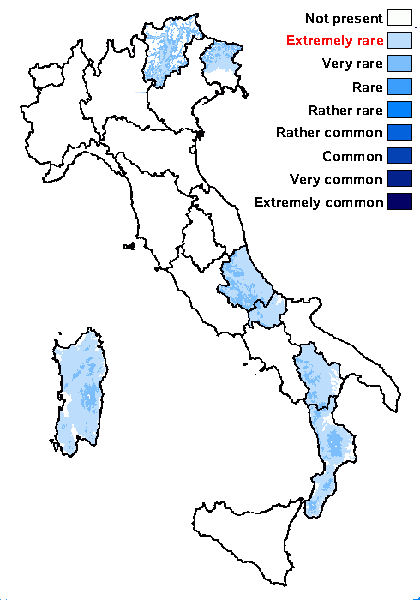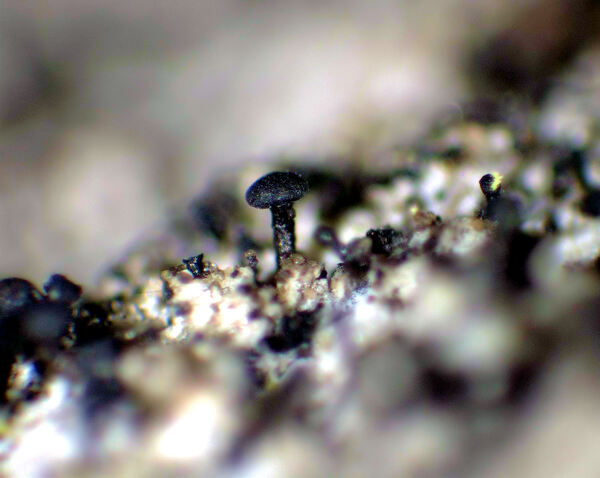Chaenothecopsis debilis (Sm.) Tibell
Symb. Bot. Upsal., 21, 2: 45, 1975. Basionym: Lichen debilis Turner & Borrer ex Sm. in Smith & Sowerby - Engl. Bot., 35: tab. 2462, 1813.
Synonyms: Calicium norvegicum Vain. ex Hav.; Chaenothecopsis elevata (Vain.) Tibell
Distribution: N - Frl (Puntillo & Puntillo 2009), TAA (Nascimbene & al. 2021). C - Abr (Puntillo & Puntillo 2009), Mol (Nimis & Tretiach 1999, Caporale & al. 2008), Sar (Puntillo & Puntillo 2009). S - Bas (Puntillo & al. 2012), Cal (Puntillo 1994, 1996, Puntillo & Puntillo 2009).
Description: Thallus not evident, not lichenized, saprobic. Apothecia long-stalked, pin-like, 0.7-1,2 mm high. Stalk 0.04-0.1 mm thick, black, the central part formed by pale, mostly periclinally arranged hyphae, the outer part wine-red, formed by strictly periclinally arranged hyphae, K- or K+ reddish, N- or N+ fleeting violet-red. Capitulum lenticular, 0.2-0.4 mm across, black but sometimes with white, cottony hyphae on lower side, with a more or less well-developed exciple consisting of several layers of reddish brown, periclinally arranged hyphae reacting K-, and N-; mazaedium not present. Epithecium brown to reddish brown, K-, N-; hypothecium brownish or faintly greenish brown, 85-100 µm high high, K-, N- or N+ intensifying reddish brown. Asci 8-spored, cylindrical, with a thickened apex penetrated by a narrow canal, formed singly, persisting until the spores are mature. Ascospores 1-septate, the septum distinct, medium brown, ellipsoid, 7-9 x 2.5-3 µm, with a smooth or minutely areolate wall. Pycnidia black, subglobose or usually elliptical and orientated along the fibres of the wood. Conidia hyaline, curved, 3-6 x c. 1 µm. Photobiont absent. Spot tests: epithecium, exciple and hypothecium K- or K+ reddish, N+ more intensely red. Chemistry: a reddish unidentified pigment in the ascomata, sometimes in very low concentrations.Note: on dry and weathered lignum of deciduous trees (Populus, Fraxinus, Ulmus), more rarely on conifers, in open situations, often in hollows of the trunks in species-poor stands; probably overlooked and more widespread, but never common.
Growth form: Fungus
Substrata: lignum
Reproductive strategy: mainly sexual
In underhangs rarely wetted by rain
Commonnes-rarity: (info)
Alpine belt: absent
Subalpine belt: absent
Oromediterranean belt: absent
Montane belt: very rare
Submediterranean belt: extremely rare
Padanian area: absent
Humid submediterranean belt: extremely rare
Humid mediterranean belt: absent
Dry mediterranean belt: absent

Predictive model
Herbarium samples
Growth form: Fungus
Substrata: lignum
Reproductive strategy: mainly sexual
In underhangs rarely wetted by rain
Commonnes-rarity: (info)
Alpine belt: absent
Subalpine belt: absent
Oromediterranean belt: absent
Montane belt: very rare
Submediterranean belt: extremely rare
Padanian area: absent
Humid submediterranean belt: extremely rare
Humid mediterranean belt: absent
Dry mediterranean belt: absent

Predictive model
| Herbarium samples |
 INDEX FUNGORUM
INDEX FUNGORUM
 GBIF
GBIF
 DOLICHENS
DOLICHENS



